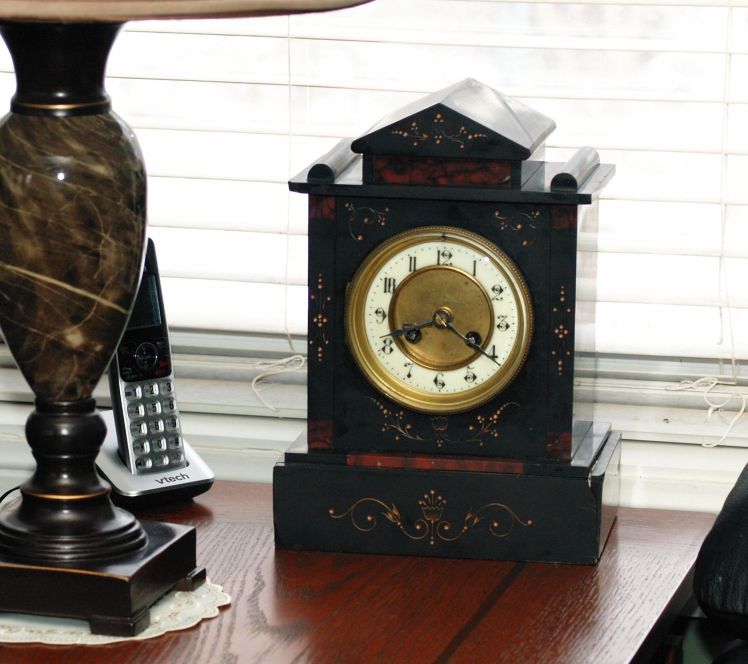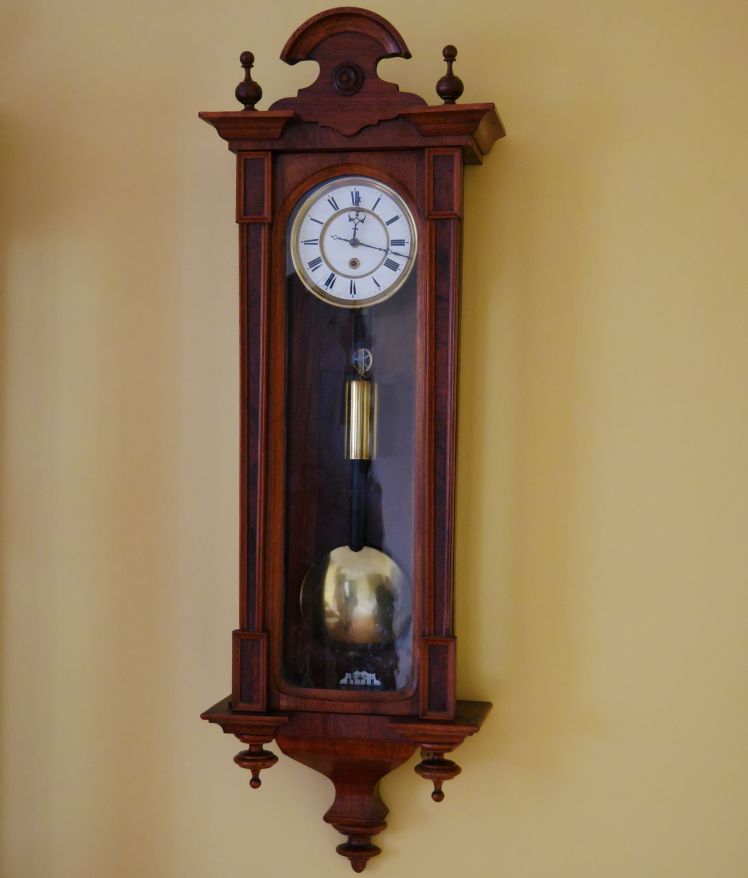Regulating your clock is the act of making repeated adjustments to your clock with the intent of achieving a desired affect, that is, making your clock a more reliable timekeeper.
Three things will affect the running of your mechanical clock, and neglect, friction & environment, and these three factors will influence whether or not your clock will keep time reliably.
Neglect
Neglect is relatively simple to explain. If you don’t take care of it, it will not be a reliable timekeeper. Transporting a pendulum clock from one place to another, for example to another room, without taking the pendulum out will lead to internal damage. Exposing the clock to the sun’s rays in a hot window will quickly age the case and dry out the movement. Placing a clock on or near a warm surface such as a heating vent will effect how your clock runs. Transporting a weight driven clock with the weights still in the case will lead to broken case parts and shattered glass. Turning the hands backwards is never a good thing unless the manufacturer specifically states in the clock instructions that it is safe to do so.

Friction
Every moving part of a clock must be in good condition. The gear train must be free to move but any excess friction will have an adverse effect on the running of your clock. Lubrication, on a regular basis, is essential. Friction leads to wear and wear leads to expensive and time-consuming repairs. Over a period of time bushing wear will accelerate and your clock will stop.
Lubricating your clock once a year or at least once every two years is a good practice


Lubricating your clock(s) once a year or at least once every two years is a good practice. Once the oil is used up or dries out the clock continues to run but the wheels are running without lubrication in their pivots holes. Once the pivot holes are enlarged (see above) the gears begin to run too deep into each other and the clock eventually stops. In clock circles this is called “meshing”. Once wear enters the equation, winding the springs do nothing as there is not enough power in the springs to overcome friction in the gear train. This leads some owners to believe that the clock is stopping because it is “over-wound” when in fact it is simply worn out. Preventative practices mitigate costly repairs.
Black or green oil around or in the pivot holes is a indication that re-oiling will be ineffective
Servicing a clock is a separate topic altogether but black or green oil around or in the pivot holes is a indication that re-oiling will be ineffective and dis-assembly and cleaning of the movement becomes absolutely necessary. Old dirty clock oil mixed with new oil will accelerate wear.
Environment
Changes in the ambient temperature of your environment will affect it’s timekeeping rate. It is quite common to make seasonal adjustments to your clock. If you are in a temperate climate like my part of the world, humidity and temperature changes have a noticeable effect on the rate-keeping of any clock. Increasing the ambient temperature will slow it down, from the expansion and lengthening of the pendulum rod (unless it has a compensating type pendulum).
Clocks will preform better in the relatively controlled environment of a home but damp basements, window sills, bathrooms, above heating elements/vents, garages and other humid areas are unhealthy locations for your mechanical clock. Not only are harsh environments hard on the movement but the case/cabinet will suffer the ill effects of cracks, fading, detached veneer and so on.

Turning the rating screw clockwise shortens the pendulum (faster) and counterclockwise to lengthen (slower)
Regulating your clock
Regulating a clock often means making incremental changes to the length of the pendulum by means of a rate adjustment screw located at the end of the pendulum, or as in the case of a French clock pendulum (above) a rating screw inside the bob. Turning the rating screw clockwise shortens the pendulum (faster) and counterclockwise lengthens (slower) it. Usually one full turn of the screw means adding or subtracting a minute per week. To simplify the process some clocks have a rate adjustment arbour on the dial, typically at the 12 o’clock position. That way you do not have to open the access door to adjust the rating nut on the pendulum.

If you have a double-ended key the smaller end is used for the rate adjustment arbor. “S” (slow) and “F” (fast) correspond to the direction to slow or speed up the clock. Clocks will often have one or the other but sometimes both (adjustable pendulum and rate adjusting arbour) as in this French shelf clock.

Rate adjustment is a trial and error process and typically takes a week or longer. If you can get your mechanical clock within a minute or two per week you are doing well. You will gradually gain a feel for the kind of adjustment required to regulate your particular clock.
Clocks without pendulums are those that have lever escapements, floating balance escapements or balance wheel escapements. Regulation is achieved by moving a lever from slow to fast or adjusting weights in one direction or another on the escape wheel. There are specific directions on how to this and it is best to consult the instruction manual on your clock or search for resources online.
Mainspring power and regulation
When winding a spring driven clock you are winding a sturdy coiled metal spring. The mainspring is an energy storage system or a power source. When you turn the key the winding gets tighter until you cannot turn the key any further. This stored energy is now ready to be released but because a clock has reduction gears and an escapement (method for energy to escape) the energy is designed to be released at a steady and controlled rate. The purpose of the gear train is to convert the slow rotation of the main wheel into the faster rotation needed to tell the time. Each wheel in the train turns faster than the previous one.
A spring driven clock tends to release most of its energy at the beginning of a cycle and releases less energy towards the end of it’s winding cycle which is typically an 8-day period. Most clocks will run longer than eight days but will lose more time as the spring supplies less power.

My Sessions time and strike tambour style clock typically runs 1 minute fast at the beginning of the week and about a minute slower at the end of the week. This is normal.

Some spring driven clocks can be difficult to regulate because of how they release their power though this may vary from one clock-maker to another. If your vintage or antique spring driven mantel or wall clock is accurate to within 1-2 minutes per week you are doing very well.
On the other hand, weight driven clocks are more accurate since they release power at a constant rate through the winding cycle. Weight driven clocks are generally more reliable timekeepers and are easier to regulate.

Neglect, friction & environment are three factors that will influence whether or not your clock will keep time reliably. Prolonging the life of your clock through a combination of good maintenance and common sense not only retains its value but will give you years of pleasure.

This is more practical info than I’ve found anywhere else.
LikeLike
I try to help as much as I can.
Ron
LikeLike